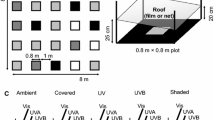Abstract
The response of rhizosphere microbial communities associated with natural populations of Deschampsia antarctica growing on Léonie Island (67°36′S, 68°21′W, Antarctic Peninsula) to UV radiation was investigated. UV radiation was controlled in the field using Perspex VA screens (UV-B opaque) which transmit little radiation below 380 nm but allow penetration of approximately 92% of radiation above 400 nm, and Perspex OXO2 screens (UV-B transparent) which transmit approximately 70% of radiation at 280 nm, rising to 90% at 300 nm and above. Reducing ambient UV radiation altered the phenotypic profile of the rhizosphere microbial community. This alteration was expressed as enhanced carbohydrate and carboxylic acid utilisation by the rhizosphere micro-organisms. It is hypothesised that ambient levels of UV radiation indirectly affect rhizosphere micro-organisms by influencing the quality or quantity of root exudates.

Similar content being viewed by others
References
Anhalt S, Weissenböck G (1992) Subcellular localization of luteolin glucuronides and related enzymes in rye mesophyll. Planta 187:83–88
Beggs CJ, Wellmann E (1994) Photocontrol of flavonoid biosynthesis. In: Kendrick RE, Kronenberg GHM (eds) Photomorphogenesis in plants. Kluwer, Dordrecht, pp 733–751
Day TA, Ruhland CT, Grobe CW, Xiong F (1999) Growth and reproduction of Antarctic vascular plants in response to warming and UV radiation in the field. Oecologia 119:24–35
Ellis RJ, Thompson IP, Bailey MJ (1995) Metabolic profiling as a means of characterizing plant-associated microbial communities. FEMS Microb Ecol 16:9–18
Garland JL, Mills AL (1991) Classification and characterization of heterotrophic microbial communities on the basis of patterns of community-level sole-carbon-source utilization. Appl Environ Microbiol 57:2351–2359
Gehrke C, Johanson U, Callaghan TV, Chadwick D, Robinson C (1995) The impact of enhanced ultraviolet-B radiation on litter quality and decomposition processes in Vaccinium leaves from the Subarctic. Oikos 72:213–222
Grayston SJ, Griffith GS, Mawdsley JL, Campbell CD, Bardgett RD (2001) Accounting for variability in soil microbial communities of temperate upland grassland ecosystems. Soil Biol Biochem 33:533–551
Gwynn-Jones D (2001) Short-term impacts of enhanced UV-B radiation on photoassimilate allocation and metabolism: a possible interpretation for time-dependent inhibition of growth. Plant Ecol 154:67–73
Huiskes AHL, Lud D, Moerdijk-Poortvliet TCW (2001) Field research on the effects of UV-B filters on terrestrial Antarctic vegetation. Plant Ecol 154:77–86
Johnson D, Campbell CD, Lee JA, Callaghan TV, Gwynn-Jones D (2002) Arctic microorganisms respond more to elevated UV-B radiation than CO2. Nature 416:82–83
Kerr RA (1988) Ozone hole bodes ill for the globe. Science 241:785–786
Klironomos JN, Allen MF (1995) UV-B-mediated changes on below-ground communities associated with the roots of Acer saccharum. Funct Ecol 9:923–930
Lewis Smith RI (1997) Oases as centres of high plant diversity and dispersal in Antarctica. In: Lyons WB, Howard-Williams C, Hawes I (eds) Ecosystem processes in Antarctic ice-free landscapes. Balkema, Rotterdam, pp 119–128
Lewis Smith RI (2003) The enigma of Colobanthus quitensis and Deschampsia antarctica in Antarctica. In: Huiskes AHL, Gieskes WWC, Rozema J, Schorno RML, van der Vies SM, Wolff WJ (eds) Antarctic biology in a global context. Backhuys, Leiden
Lud D, Huiskes AHL, Moerdijk TCW, Rozema J (2001) The effects of altered levels of UV-B radiation on an Antarctic grass and lichen. Plant Ecol 154:89–99
Lud D, Schlensog M, Schroeter B, Huiskes AHL (2003) The influence of UV-B radiation on light-dependent photosynthetic performance in Sanionia uncinata (Hedw.) Loeske in Antarctica. Polar Biol 26:225–232
Madronich S (1999) Stratospheric ozone and its effects on the biosphere. In: Gilbert DL, Colton CA (eds) Reactive oxygen species in biological systems: an interdisciplinary approach. Kluwer, Mass., pp 317–334
Madronich S, McKenzie RL, Caldwell MM, Bjorn LO (1995) Changes in ultraviolet radiation reaching the earth's surface. Ambio 24:143–152
Newsham KK, Splatt P, Coward PA, Greenslade PD, McLeod AR, Anderson JM (2001) Negligible influence of elevated UV-B radiation on leaf litter quality of Quercus robur. Soil Biol Biochem 33:659–665
Pyle JA (1997) Global ozone depletion: observations and theory. In: Lumsden P (ed) Plants and UV-B: responses to environmental change. Cambridge University Press, Cambridge, pp 3–12
Rozema J, van de Staaij J, Björn LO, Caldwell M (1997) UV-B as an environmental factor in plant life: stress and regulation. Trends Evol Ecol 12:22–28
Rozema J, Broekman R, Lud D, Huiskes AHJ, Moerdijk T, de Bakker N, Meijkamp B, van Beem A (2001) Consequences of depletion of stratospheric ozone for terrestrial Antarctic ecosystems: the response of Deschampsia antarctica to enhanced UV-B radiation in a controlled environment. Plant Ecol 154:103–115
Russell JM, Luo M, Cicerone RJ, Deaver LE (1996) Satellite confirmation of the dominance of chlorofluorocarbons in the global stratospheric chlorine budget. Nature 379:526–529
Shanklin J (2003) The Antarctic ozone hole. Br Antarct Surv Internet WWW page at: http://www.nerc-bas.ac.uk
Xiong FS, Day TA (2001) Effect of solar ultraviolet-B radiation during springtime ozone depletion on photosynthesis and biomass production of Antarctic vascular plants. Plant Physiol 125:738–751
Yue M, Li Y, Wang X (1998) Effects of enhanced ultraviolet-B radiation on plant nutrients and decomposition of spring wheat under field conditions. Environ Expt Bot 40:187–196
Acknowledgements
We are grateful to Dr. P. Convey and A. Rossaak for collecting the field samples, Dr. H.J. Peat for providing the Bentham Spectroradiometer data, and Dr. S. Harangozo for providing meteorological data. Drs K.K. Newsham and A.H.L. Huiskes supplied useful comments on the manuscript for which we are grateful. Lisa Avery was in receipt of a University of Nottingham studentship whilst this work was undertaken.
Author information
Authors and Affiliations
Corresponding author
Rights and permissions
About this article
Cite this article
Avery, L.M., Lewis Smith, R.I. & West, H.M. Response of rhizosphere microbial communities associated with Antarctic hairgrass ( Deschampsia antarctica ) to UV radiation. Polar Biol 26, 525–529 (2003). https://doi.org/10.1007/s00300-003-0515-y
Received:
Accepted:
Published:
Issue Date:
DOI: https://doi.org/10.1007/s00300-003-0515-y




